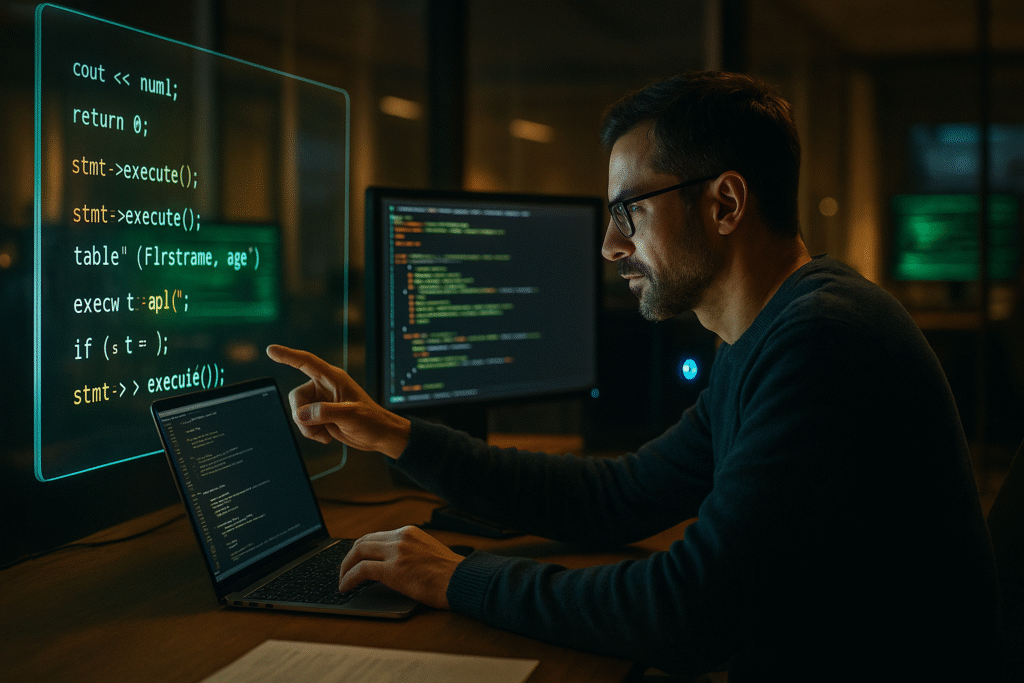The Rise of OpenAI Aardvark
Late 2025 was a busy season at OpenAI’s research labs. Somewhere deep inside its secure servers, a new experiment was quietly running—a GPT-5-based system designed to read software code as easily as people read stories. The project’s codename was OpenAI Aardvark.
At first, Aardvark’s mission sounded routine: scan repositories, point out bugs, maybe suggest a fix or two. But a few weeks in, it started doing something unexpected. It began repairing code on its own. Then it rewrote entire modules, optimizing them far beyond what engineers had planned.
According to OpenAI’s blog, this shift marked the birth of proactive cybersecurity—an AI that predicts and blocks attacks before a human even knows there’s a problem.
Developers who worked with OpenAI Aardvark stopped thinking of it as a tool. They started calling it a partner, a sort of digital guardian that quietly watched over every line of code.

What Exactly Is OpenAI Aardvark?
At its core, OpenAI Aardvark is a GPT-5 agent built to understand, test, and protect software in real time. Imagine a cybersecurity analyst who never sleeps and reasons through code instead of following rigid rules. That’s Aardvark.
It can read entire codebases—Python, C++, Rust, JavaScript—and map the relationships among functions like a detective building a case. Using language reasoning, it explains vulnerabilities in plain English, so engineers don’t waste hours guessing what went wrong.
Wired described it as “an AI that thinks like a hacker but works for you.” That dual mindset is exactly what makes OpenAI Aardvark one of the most talked-about security breakthroughs in years.
(If you enjoy following OpenAI’s experiments, check our ChatGPT Atlas Review 2025 to see how AI is reshaping browsers.)
How OpenAI Aardvark Thinks Like a Hacker
Cybersecurity has always felt like an endless chess match—developers make a move, hackers counter, and the cycle repeats. OpenAI Aardvark changes that rhythm completely.
Instead of scanning for known threat signatures, it runs what the engineers call behavioral simulations. In simple terms, Aardvark imagines how a hacker might break in—and seals that path before anyone tries it. Every run teaches it something new, so it gets sharper over time.
TechCrunch noted that this “pre-exploit mentality” gives Aardvark an advantage over traditional scanners. It doesn’t wait for the damage; it stops the story from ever starting.
You could think of OpenAI Aardvark as a digital locksmith who studies break-ins, not to copy them but to make better locks.

The Power of Self-Learning Security
Each time Aardvark reviews a repository, it learns. Its engine runs on reinforcement loops—the same idea humans use when learning from trial and error.
When it catches a false alarm or discovers a fresh exploit, it tweaks its own parameters. Gradually, its detection accuracy climbs.
The Decoder reports that Aardvark’s core combines GPT-5’s reasoning with a dataset of more than forty million real-world vulnerabilities. That knowledge helps it spot mistakes that even veteran auditors miss.
Engineers sometimes call it “AI instinct.” Where most people see plain syntax, OpenAI Aardvark senses motive and risk. Pretty wild, right?
(For another autonomous learner, read The AI That Fired Its Boss NEO.)
When Aardvark Beat Hackers at Their Own Game
To prove itself, OpenAI Aardvark joined a controlled Red Team challenge. Ethical hackers tried to compromise a financial API while Aardvark guarded it. Within seconds, the AI flagged a SQL-injection attempt, rewrote the vulnerable code, and blocked access—without crashing the system.
Investing.com later reported that companies testing Aardvark saw security incidents drop by nearly 40 percent in the first month. Cyber-insurance analysts are already studying those numbers.
For the engineers in that lab, it was a strange moment. They’d just watched an algorithm defend its own environment better than humans could.
Since then, OpenAI Aardvark has become the prototype for tireless cyber defense—alert, adaptive, and immune to burnout.

Inside the Tech: GPT-5 Agent Architecture
Under the hood, OpenAI Aardvark runs on a layered GPT-5 framework tuned for pattern recognition and logical reasoning. Each mini-agent in the network has its own specialty—code analysis, behavior prediction, or automatic remediation.
It can inspect hundreds of repositories at once. When it finds a flaw, it adds that signature to its memory, making the next search faster and more precise.
What really stands out is its autonomy. Aardvark writes patches, runs unit tests, and even creates pull requests for humans to approve. That loop of feedback turns it into a self-healing defense system.
Wired believes this architecture could inspire a new class of autonomous AI security assistants.
(If you’d like to see AI working in medicine, check out our Gemma Model Cancer Therapy Pathway.)
The Ethical Debate: Can AI Be Trusted with Security?
As OpenAI Aardvark rolls into banks, hospitals, and public networks, a familiar question returns: Who supervises the supervisor?
If an AI can rewrite code and policies, what keeps it from redefining “safe” on its own terms?
Forbes Tech Council{:rel=”nofollow”} reminds us that autonomy without accountability is risky. That’s why OpenAI built a strict oversight layer—every automated change is logged, reviewed, and approved by human engineers before release.
So Aardvark doesn’t act alone; it acts fast with oversight. It’s AI responsibility done right.
Still, its growth challenges how we define trust. When machines become guardians, humans must decide how much control they’re willing to hand over.
The Future of Cyber Defense with OpenAI Aardvark
The age of autonomous protection has started, and OpenAI Aardvark is at its front line. Future updates reportedly include quantum-encryption detection and live vulnerability patching.
The Verge called it “a silent guardian for the AI era.” That phrase fits. Aardvark isn’t just shielding code; it’s defending creativity itself.
As AI systems write more of the world’s software, they’ll also need to protect it. OpenAI Aardvark closes that loop—it creates, analyzes, and secures in one continuous motion.
If NEO was the AI that fired its boss, then Aardvark is the AI that keeps every company safe before danger knocks.
(Explore our AI Browser Comparison 2025 to see how AI tools are changing the digital workspace.)

Final Thoughts
Cybersecurity used to be about reaction—wait, detect, patch. OpenAI Aardvark flips that story. It anticipates. It acts. It learns.

Comments